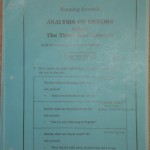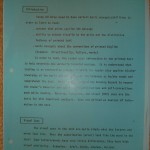Artifact: Case 2
Standard 2 emphasizes the professional nature of education in highlighting two attributes that is often associated with professionalism: ethical and honest. I understand this standard as acting in such a way as to gain the trust of people that we communicate with as well as bystanders who witness these interactions. When educators are in conversation with parents, trust is given in the form of private and sensitive information. While in the school, educators are in a position of authority, leading to educators often seen as role models to students and adults alike. Thus in essence, because educators are placed in a position of trust and authority, we must act in a professional manner in all public situations.
The artifact I chose for this standard is case number 2 from a university course in the education program. In it is a paragraph depicting a mother complaining about a previous teacher to the current teacher. Immediately this situation touches on the issue of ethical behaviour on the part of the current teacher. The dilemma in this case was whether it is ethical to engage in conversation regarding another professional with a client in a general sense.
What my experience the past year has taught me is that there can be situations where honesty doesn’t always result in ethical behaviour. An example is if a parent asks for my opinion on a matter which it would be unethical for me to answer. Prior to being exposed to case 2’s scenario and being ignorant of the full legalities behind teacher professionalism, I would have been undecided between unethically granting the parent’s wish to discuss another teacher and honestly informing the teacher of this parent’s criticisms. Fortunately, the case was presented early in the year and as a result, prepared me for the possibility of such a decision during the practicums following. After learning some of the correct protocol in situations like the one described, my conclusion to that case was to “redirect Tella’s mother to voice her complaints to last year’s teacher or ask consent to have her complaints relayed directly to last year’s teacher”. So it was with the guidelines presented in the BCTF Code of Ethics that I addressed this issue of deciding between ethical behaviour and honesty.
Case 2 taught me more than protocols, legalities, and choices because it also made me realize that the profession of education is on the one hand connected to laws, but on the other hand is linked in relationships with the school community. It is the balance between the two that all teachers must find. It is a balance that I’ve begun to see and experience for myself this past year. In my future teaching years, I believe that in order to adhere to the laws that govern us as well as build strong relationships with whichever school community I’m at, I must act professionally at all times, and to do so, I will keep an ethical and honest behaviour as a strong opening step in achieving that goal.




